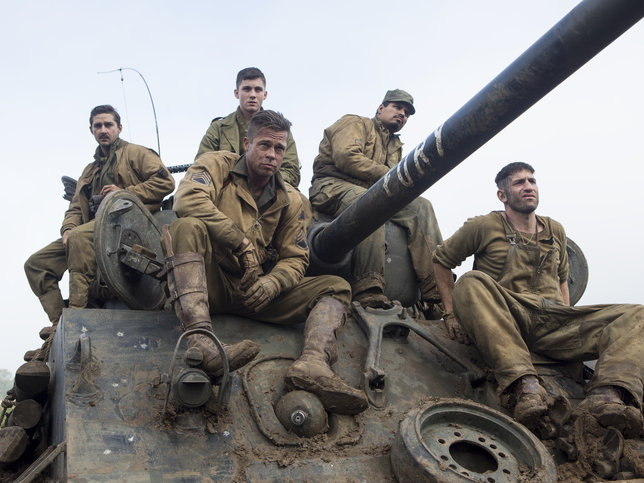Writer-director David Ayer has built a solid career out of plasma and profanity splattered stories about brotherhoods of men (and, in the case of "Sabotage," the occasional woman) corrupted by violence, as well as the gray line between good guys and bad guys.
"Fury," however, marks a drastic change for Ayer. His latest film trades out his usual playground – the grim, gritty streets of Los Angeles – for the grim, gritty mud paths of Germany in order to tell something completely new: a World War II story … a plasma and profanity splattered WWII story about a brotherhood of men corrupted by violence, as well as the gray line between good guys and bad guys. So maybe saying "drastic change" and "something completely new" was a bit generous.
Whether comparing it the rest of Ayer’s resume or merely to other WWII films, there’s something fairly familiar about "Fury" – other than the fact that it’s certainly more brutal than most. As the rare tank-based WWII action movie, Ayer’s latest decently satisfies. When "Fury" tries to be anything more, however, the story’s treading gets gummed up, and the effective machine loses steam.
The film opens on the final gasps of World War II, with all of Europe inflected a toxic combination of desolation and desperation (the opening shot follows a lone soldier and horse trotting across a German battlefield, but it could easily be confused for a martian wasteland). The roads are paved gray with rotting men and rancid mud, driven over equally without pity.
In war, you either kill or wind up just another corpse in the dirt. At least, that’s the essential mantra for Wardaddy (a scarred, grizzled Brad Pitt), an American tank commander leading his tired troop of fighting survivors (including a Bible-quoting Shia LaBeouf, Ayer’s "End of Watch" star Michael Pena and a rabid Jon Bernthal) through Nazi Germany. After their gunner dies in an early, off-screen battle, the seasoned – and possibly psychotic – crew gets a fresh-faced, nervy and preferably office-bound rookie named Norman (Logan Lerman) to break into a Nazi killer. His first order of business? Cleaning up the splattered face of his predecessor.
Over the course of a few missions and encounters – from graphically plowing through entrenched German infantries to a brief break with some understandably hesitant but sweet locals in an invaded village – Norman eventually evolves into "Machine," the dehumanized angry machine gunner Wardaddy and company insist they need to survive the muck of war.
Taken on simply action movie terms, this all works fairly well. Ayer stages some impressive and intense tank battles. The setting and end results may be muddy and messy, but Ayer films the action cleanly. Bullets – glowing tracer rounds, giving the fights an odd laser gun look at first glance – and mortar shells whizz and ricochet past the tank and, thanks to the sound design, seemingly the audience. You’d be easily forgiven for quick ducking.
It all helps put the viewer right in the heat and the horror of battle, even more so thanks to Ayer’s usual feel for detail and unusual choice of setting. Tanks have often served as an action movie accessory but not so much as the focal point, despite the cinematic potential of a claustrophobic high pressure cooker. The memorable 2009 Israeli war drama "Lebanon" knew that, cooping the audience inside a cramped, dank and dirty tank for almost the entire running time. Tensions were constantly on edge, while grease and grime dripped an oozed everywhere. By the end, you were crying for sunlight and a long shower.
"Fury" spends far more time outside the Sherman’s metal walls, but Ayer still fills the film with plenty of gritty detail. The excitement isn’t in quick sharp action, but in the intense process and minutiae of getting a lumbering steel death cocoon into the perfect position.
During the crisply shot tank battles, the director constantly hops back and forth between the various cramped human cogs inside the Sherman, barking out orders, loading up the huge artillery and making the careful adjustments that narrowly mean the difference between a direct hit and a close scrape – one followed by seemingly endless anxious seconds of going through the whole process again. Ayer captures all of that authenticity and, combined with the detailed muddy world of decay and death outside, creates a lived-in war.
Unfortunately, that precise and carefully honed feel for the fine details in the action is missing with the story. There’s not much of a constant plot going through Ayer’s script; instead, it’s mostly just a series of violent encounters. Considering how violent those battles are and how meandering the story is, "Fury" begins to feel like simply a relentless tour of grim brutality.
That’s partly what Ayer is going for, a study into the ugly decimating power of war – especially in its most desperate hours – and the men turned into savages by its vicious basic premise: kill or be killed. The sad shots of destroyed humanity, Steven Price’s haunted score and the screenplay’s occasional dabbling into religion and morality make that mission clear.
Story-wise, however, it just never seems to come together in a particularly meaningful manner. The characters are left as mostly sketches, easily defined by their nicknames (LaBeouf’s "Bible" quotes the Bible, Bernthal’s "Coon-Ass" is a vulgar loose cannon) or cheap stereotypes. Across the board, the performances – all quite good, especially Labeouf and his reserved simmer – bring more than the page can deliver.
For the characters to come up short is a significant issue considering they, not an overarching story, are the focus, put in a gray, bloody Petri dish of war and put under the microscope. Around the midway point, Ayer tries to show how boorish and corrupted these soldiers have become, with a delicate and sweet brief afternoon between Wardaddy, Norman and a holed-up German mother-daughter hijacked by the other three drunken crewmates. Since the characters aren’t really working, however, the scene falls somewhat flat, yet another ugly stop on the road.
It, and Norman’s evolution into the angry "Machine," seems even more off considering the final act. After setting up its grim characters and vision of war for 90 minutes, "Fury" turns into a kind of conventional last stand feature, with the tank busted and the men facing impossible odds while earning a variation of nobility and heroism marked with brotherhood, blood and sacrifice. Like much in the story, it just doesn’t gel, the crew’s moral degradation and corruption – made very clear over the last two acts – pushed aside for a good climactic action sequence.
And it is a good climactic action sequence. Like the rest of the tank sequences, Ayer brings it all together in an intense, gritty package. But for a movie with the essential message of "War is hell," other than being more brutal than usual, it comes off trite and empty. Think of a movie like "Saving Private Ryan" (or another Spielberg war flick, "Munich"), where each character’s death felt like a sickening blow. Here, "Fury" may pack a big gun, but it doesn’t leave much of a dent.
As much as it is a gigantic cliché to say that one has always had a passion for film, Matt Mueller has always had a passion for film. Whether it was bringing in the latest movie reviews for his first grade show-and-tell or writing film reviews for the St. Norbert College Times as a high school student, Matt is way too obsessed with movies for his own good.
When he's not writing about the latest blockbuster or talking much too glowingly about "Piranha 3D," Matt can probably be found watching literally any sport (minus cricket) or working at - get this - a local movie theater. Or watching a movie. Yeah, he's probably watching a movie.







